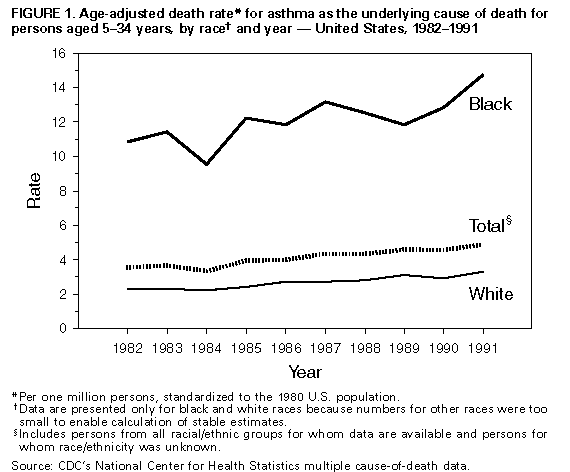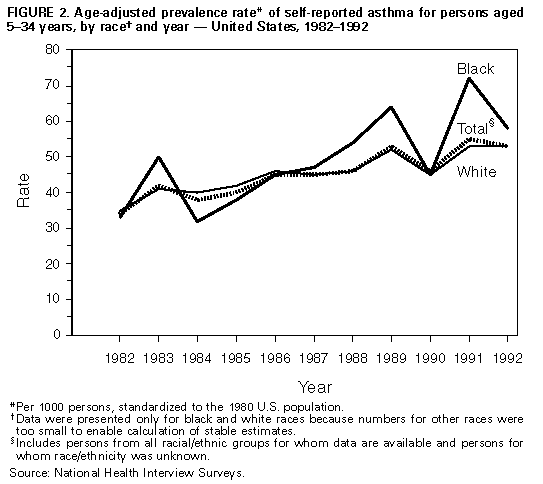 |
|
|
|
|
|
|
|
|
|
|
|
|
|
|
|
|
||||
| ||||||||||
|
|
|
|
Current Trends Asthma -- United States, 1982-1992Asthma is characterized by variable airflow obstruction with airway hyperresponsiveness; prominent clinical manifestations include wheezing and shortness of breath. During the 1980s, the prevalence of and mortality associated with asthma increased in the United States and other countries (1,2). To describe national trends in disease burden for asthma in the United States, CDC analyzed data for 1982-1992 (the most recent year for which data are available) for deaths, hospital discharges, and self-reported morbidity. This report summarizes the findings of the analysis. This analysis used data maintained by CDC, including the multiple-cause-of-death file, the National Hospital Discharge Survey, and the National Health Interview Survey. For asthma deaths, the underlying cause was listed as International Classification of Diseases, Ninth Revision, Clinical Modification, code 493. Because of the limited accuracy of diagnosing asthma in persons aged greater than 35 years (3), this analysis presents overall age-adjusted rates and rates for persons aged 5-34 years. Race-specific analyses were restricted to blacks and whites because numbers for other races were too small to enable calculation of stable estimates. From 1982 through 1991 *, the overall annual age-adjusted death rate ** for asthma increased 40% and steadily, from 13.4 per 1 million population (3154 deaths) to 18.8 per 1 million (5106 deaths). During this period, the rate increased 59% for females (from 15.4 to 24.6) and 34% for males (from 11.7 to 15.7). For persons aged 5-34 years, the rate increased 42%, from 3.4 (401 deaths) to 4.9 (569 deaths) Figure_1. The annual death rate was consistently higher for blacks than for whites. During this period, the rate increased 41% for females (from 3.6 to 4.6) and 43% for males (from 3.7 to 5.3). The overall annual age-adjusted hospital discharge rate for asthma as the primary diagnosis decreased slightly from 18.4 per 10,000 in 1982 to 17.9 per 10,000 in 1992. For persons aged 5-34 years, the rate was constant in both years (12.8 per 10,000); rates for females were consistently higher than for males, and rates for blacks were consistently higher than for whites. From 1982 through 1992, the overall annual age-adjusted prevalence rate of self-reported asthma increased 42%, from 34.7 per 1000 to 49.4 per 1000. For persons aged 5-34 years, the rate increased 52%, from 34.6 to 52.6 Figure_2. The rate for males increased by 29% (from 39.7 to 51.4) and for females increased 82% (from 29.4 to 53.6). Reported by: Air Pollution and Respiratory Health Br, Div of Environmental Hazards and Health Effects, National Center for Environmental Health, CDC. Editorial NoteEditorial Note: Three national health objectives for the year 2000 include decreasing disability and hospitalizations for asthma and increasing education about asthma (objectives 11.1, 17.4, and 17.14) (4). Although hospitalization rates for asthma were stable during 1982-1992, both prevalence and death rates increased during this period. Potential explanations for the stable hospitalization rates for asthma, despite the increased prevalence of self-reported disease, include improved outpatient treatment and, because of billing practices, classification of cases of asthma under other diagnostic categories. Prominent racial differences in asthma death rates and hospitalization rates indicate the need for further investigation of potential explanations (e.g., access to appropriate health care and socioeconomic factors). Although the specific etiology of asthma is unknown, this problem may be associated with familial, infectious, allergenic, environmental, socioeconomic, and psychosocial factors. For example, in 1991, an estimated 6.4 million (63%) of the 10.3 million persons with asthma in the United States resided in areas where at least one National Ambient Air Quality Standard was exceeded (5). Factors associated with risk for death among persons with asthma include medication overuse (6), substance abuse (7), and cigarette smoking (8). Morbidity and mortality associated with asthma may be affected by patient compliance, patient education, and medical management. In particular, a high proportion of asthma morbidity and mortality may be preventable through patient recognition and aggressive medical management. In 1989, the National Asthma Education Project was implemented to increase awareness about asthma and to improve effective control of asthma by providing physicians and patients with updated treatment information. This program has developed educational materials for patients and physicians about the treatment of asthma during pregnancy, for physicians about educating patients about asthma, and for educators about adding or improving awareness about asthma in schools. Additional information about these or other asthma materials are available from the National Heart, Lung, and Blood Institute Information Center, telephone (301) 251-1222. References
* Mortality data were not available for 1992. ** Intercensal population estimates were used to calculate age-adjusted rates standardized to the 1980 U.S. population. Figure_1  Return to top. Figure_2  Return to top. Disclaimer All MMWR HTML versions of articles are electronic conversions from ASCII text into HTML. This conversion may have resulted in character translation or format errors in the HTML version. Users should not rely on this HTML document, but are referred to the electronic PDF version and/or the original MMWR paper copy for the official text, figures, and tables. An original paper copy of this issue can be obtained from the Superintendent of Documents, U.S. Government Printing Office (GPO), Washington, DC 20402-9371; telephone: (202) 512-1800. Contact GPO for current prices. **Questions or messages regarding errors in formatting should be addressed to mmwrq@cdc.gov.Page converted: 09/19/98 |
|||||||||
This page last reviewed 5/2/01
|